ASMFC 2022 Winter Meeting- Summary
STRIPED BASS MANAGEMENT BOARD- January 26, 2022
The ASMFC Winter Meeting convened this past Wednesday, January 26 for what was largely a procedural meeting in advance of drafting Amendment 7 to the Striped Bass management plan. There were a few notable revisions to the Amendment which we discuss below.
There is some good news, most importantly, Draft Amendment 7 was approved to be released for public comment before the ASMFC meets for its spring meeting in May of 2022. Assuming approval, the plan will not go into effect fully until 2023. That is because state fisheries regulations are already in place for this year and some of the provisions will have to be formally adopted by various legislatures along the coast. That is the nature of process and more reason why greater urgency is needed to make a difference quickly.
Draft Amendment 7 will be released soon; we will then review and follow up with a full breakdown of the various sections and provide some direction on how to comment. There are four main issues the board approved for development in Draft Amendment 7; Management Triggers, Measures to Protect 2015 Year Class, Recreational Release Mortality and Conservation equivalency. What follows is our summary of the primary items discussed, the decisions made, and our position.
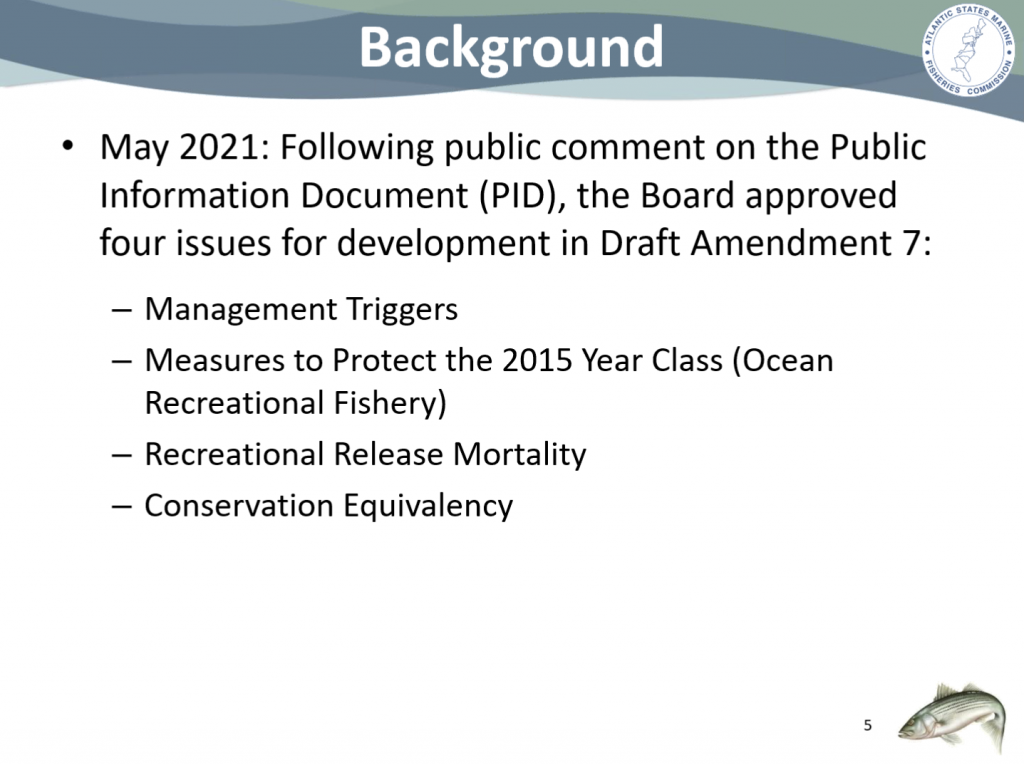
MANAGEMENT TRIGGERS
The first issue discussed was management triggers, this was a very complicated section. The CliffsNotes breakdown here is that this section could possibly delay action by the board by setting requirements for the timeline that triggers a rebuilding of the stock. As written, it would require 3 years of data to declare overfishing and kickstart a rebuilding plan. The consensus of the angling public is that the ASMFC has failed to move fast enough to recover the stock. As we have previously mentioned, the stock was declared overfished in 2018, a little over 3 years later and we are still working on a draft amendment. This section would only further delay action.
The good news here is that Megan Ware (ME) and John McMurray (NY) immediately voiced opposition and a motion was made to remove it from the draft amendment. The board needs to move as quickly as possible if there is any indication that the stock is in trouble and in our opinion, there is little downside to erring on the side of caution. The motion passed (10-6-0-0) and it has been removed, this is a real win for conservation.
YEAR CLASS PROTECTIONS
A recent addition to Draft Amendment 7 was protections for strong year classes (rec size and bag limits), more specifically for the 2015-year class. There is some data which suggests that this would not make a difference in the recovery of the stock, and that the ASMFC already missed its opportunity to protect the 2015-year class.. The Plan Development Team (PDT) suggested that this be removed and that is just what happened.
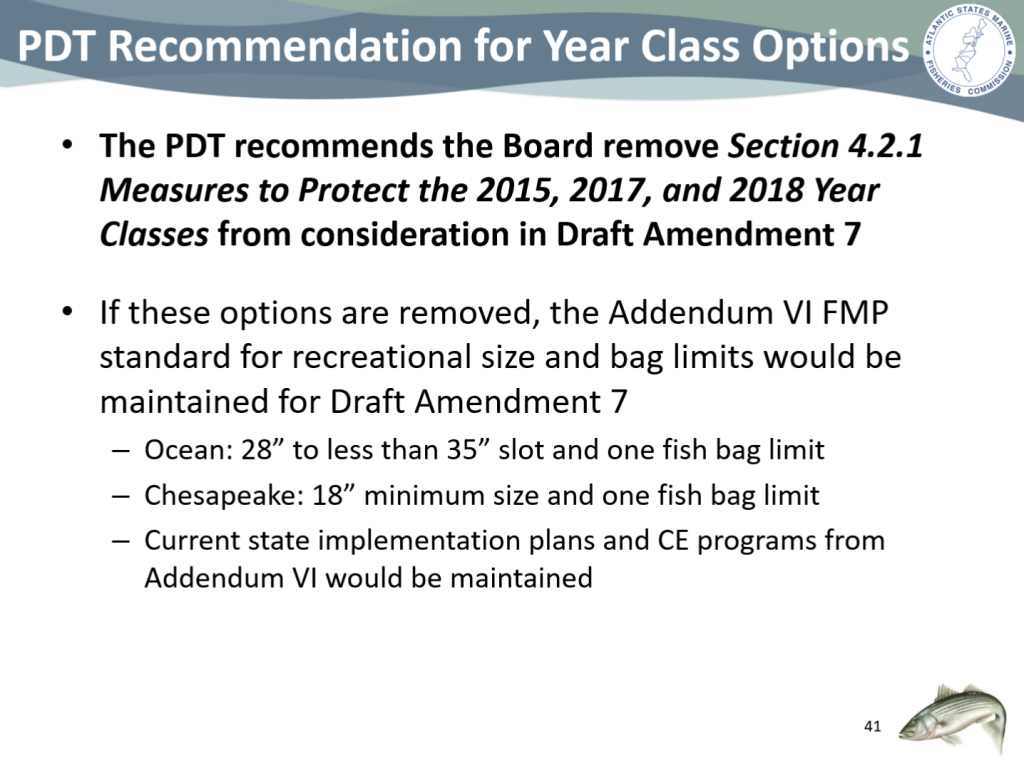
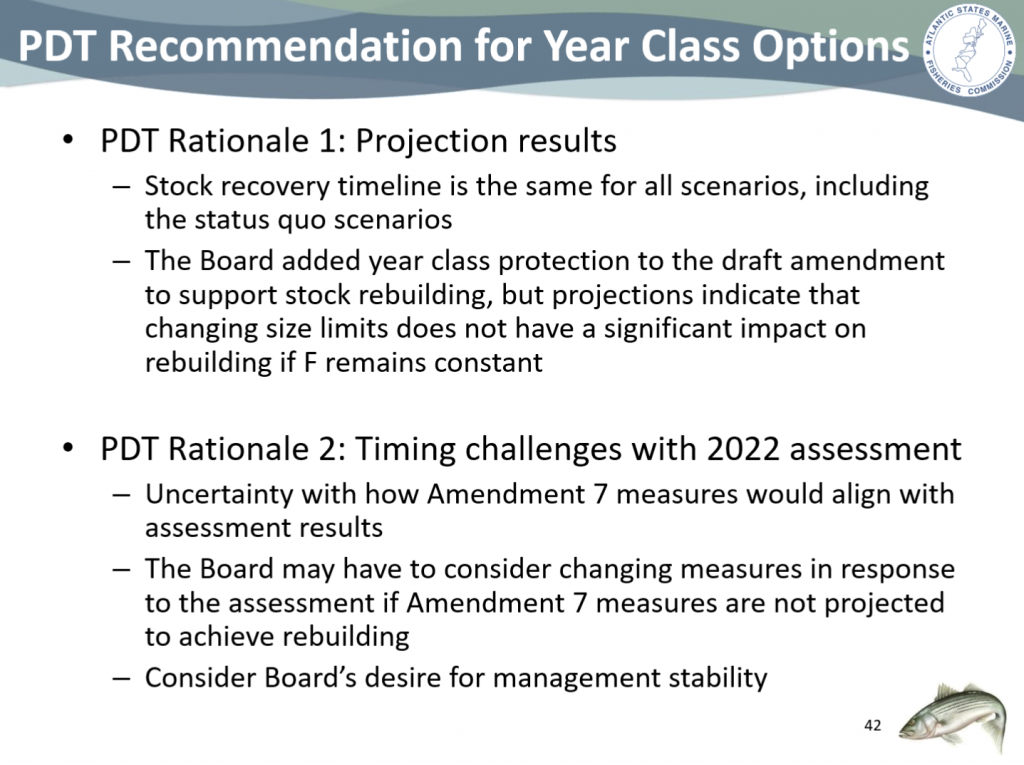
The prevailing opinion seems to be that, rather than protect a single year class, focus should be on better overall protection for all fish that run a harvest gauntlet as they migrate from the Chesapeake and up along the coast. If the idea is that stronger overall protections are needed, we support that. But we’ll see what the actual language is when the draft is made public before we offer a position for public comment.
CONSERVATION EQUIVALENCY (CE)
While there was no real discussion or changes made to the CE section of the amendment, there is an important and notable option we were all happy to see. As many of you already know there is consensus amongst almost every conservation organization that CE is often misused and abused, we would all like to see it off the table all together. While that is not the case there is some good news in the way of options B, C and D. With option B1, CE can be restricted if the stock is considered overfished, the SSB (spawning stock biomass) is below target or if overfishing is occurring. Options C and D offer restrictions based on MRIP data (needing to be more precise) and buffers to make up for the fact that CE effect can often be unquantifiable. In that case, a state applying for CE would essentially be hit with an additional reduction to make up for uncertainty of CE.
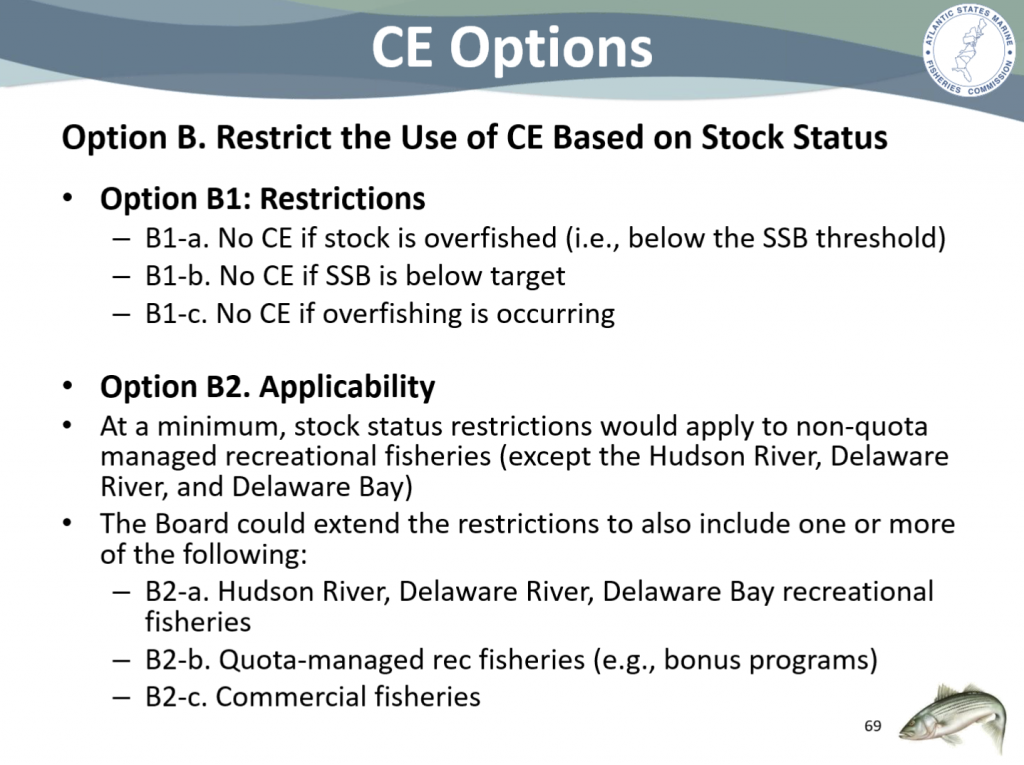
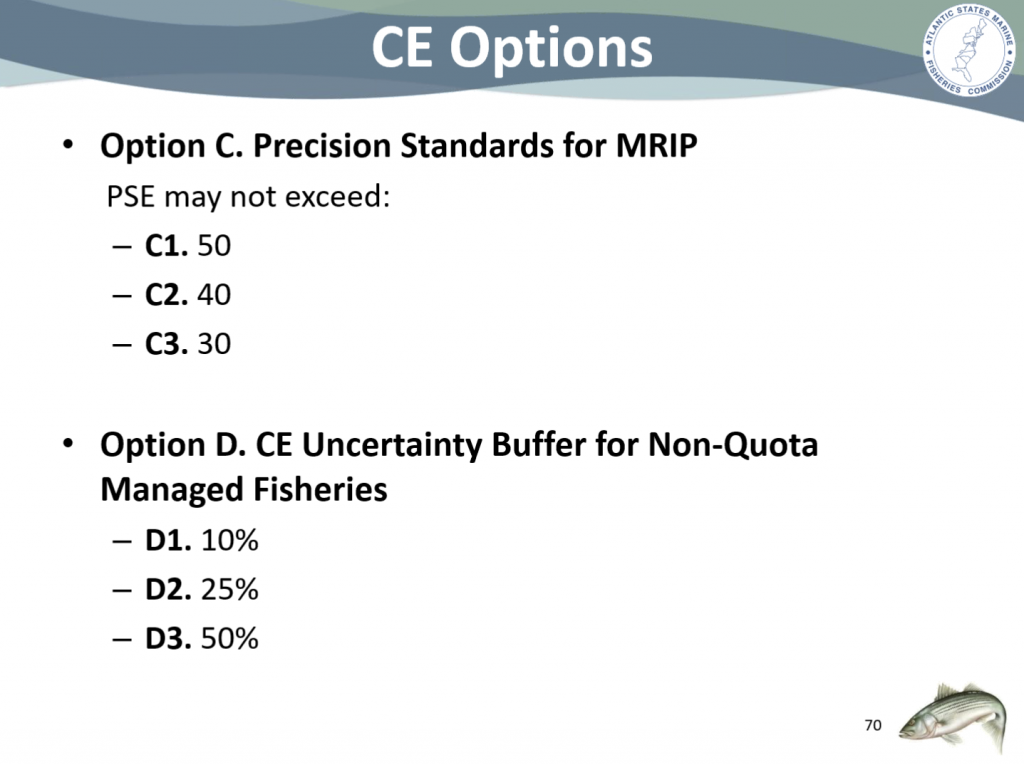
These options will be our only way to combat the misuse of CE and they will make states reconsider requesting it in the first place. We will go into more detail explaining each option when we give our summary and recommendations for comments on Draft Amendment 7. If we all rally together and speak up there is a real chance we can hit CE where it hurts and that is another win for conservation.
REBUILDING PLAN
As we have said on more than one occasion, the ASMFC is behind the 8-ball when it comes to rebuilding the stock within the required 10 years. The stock was declared overfished with overfishing occurring back in 2018, it is now 2022 and without the unknown variable of the October 2022 stock assessment it is unlikely that it will be rebuilt before 2029. The slide below shows what will happen if the stock assessment indicates that Amendment 7 as-is will be sufficient for rebuilding and what will happen if it does not. If Amendment 7 is unaffected by the assessment there will be no changes, if the rebuilding target will not be met then there would be a need for an addendum to achieve the rebuild.
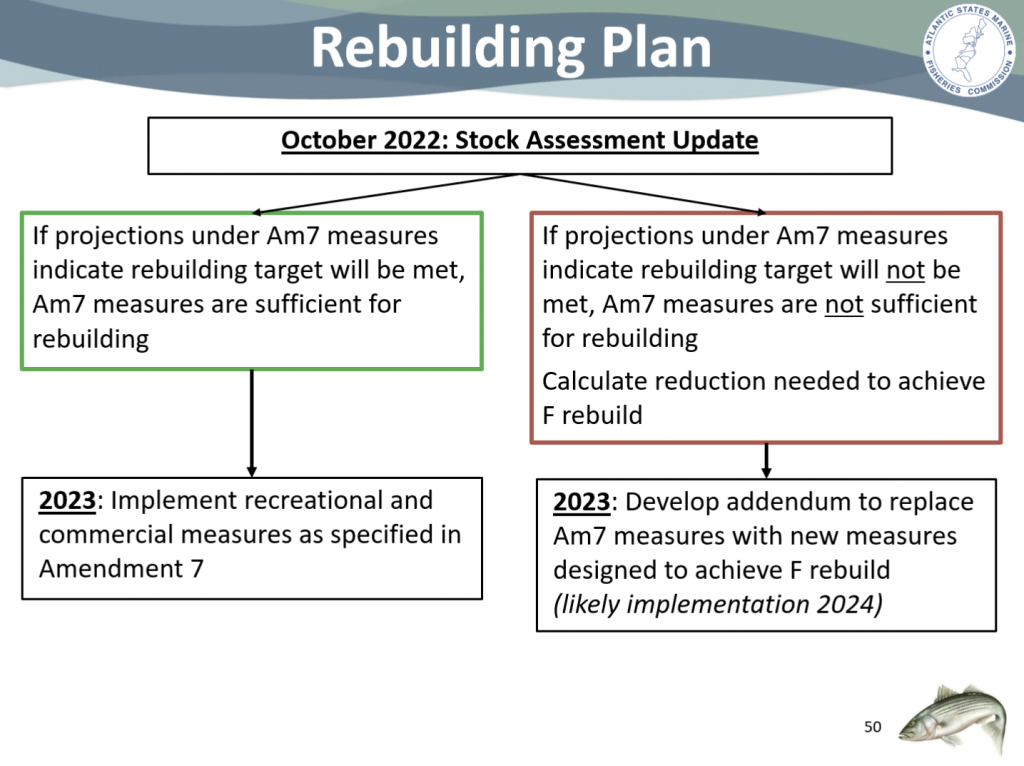
The inherent problem with the second outcome is that 2023 will be spent developing that addendum and regulations would likely not be put into place until 2024, if we are lucky. With the possibility of only five years to rebuild something had to give. That is when we saw the motion (below) from Mike Armstrong (MA).
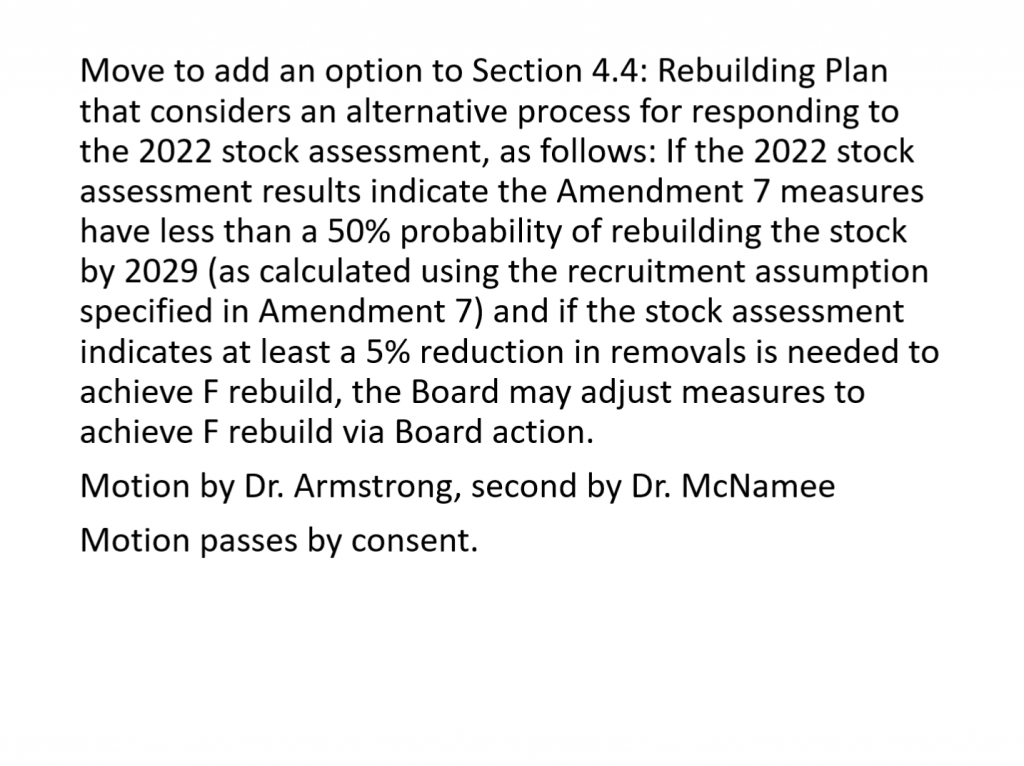
This is a one-time measure tied to the results of the 2022 stock assessment and would give the ASMFC the ability to adopt an immediate 5% harvest reduction while the full response to a potential stock emergency is drafted for consideration. Stripers Forever voiced support for this motion because it allows for decisive action in the event that the stock assessment indicates that Amendment 7 will not rebuild the stock by 2029. Thankfully the motion passed by consent of the board.
RECREATIONAL RELEASE MORTALITY
With the current mortality of recreational C&R fishing at 9% and a very large number of anglers choosing to fish (even when practicing catch-and-release), the overall impact on the stock is huge. As you see in the slide below, there are four options for helping to ease this burden on the stock.
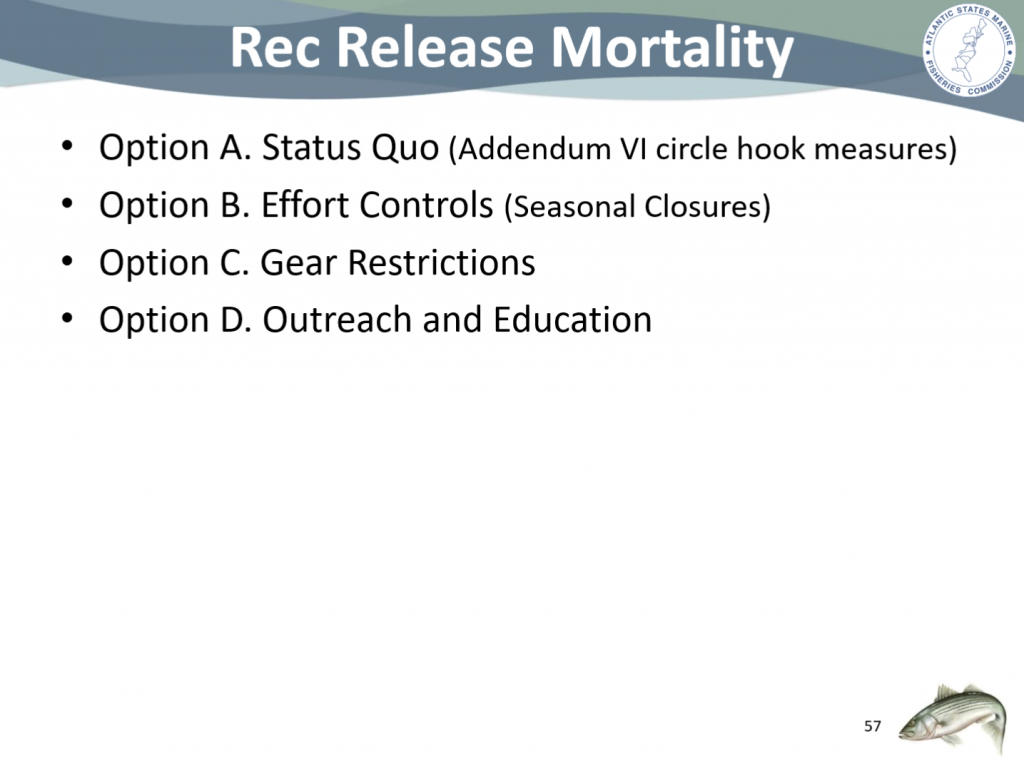
Option D, outreach and education, is a no brainer and we would expect little to no push back on support of this option. In our opinion this should a given and both the ASMFC and states should pursue this path, we have strongly suggested it in the past and we will ask that you do so again when the time comes to comment on Draft Amendment 7. Conservation organizations like Stripers Forever have been leading the way on angler education and for improving catch-and-release practice. Support from the ASMFC and individual states would be a welcome addition to the effort.
Where things get a little complicated and confusing is option B, effort controls (seasonal closures). If you fish or live near a major spawning area in the early spring you have probably been witness to the pressure put on these fish as they stage, spawn and then redisperse to continue their migration north. Each spring the NY bight is a prime example of this, and the fish take a beating, especially the large breeders as they stage in Raritan Bay, NJ. It does not take a scientist to come to the conclusion that if these fish were left alone their spawning success would increase. With the stock overfished and overfishing occurring any help is extremely important and we believe that the impact would be substantial.
Things start to go off the rails when it comes to defining these spawning areas. Seasonal closures to spawning locations would be left up to the states. This is both dangerous and confusing. While spawning areas and restrictions are well-defined in the Chesapeake, this is not the case in Delaware Bay or the Hudson River. It also leaves vulnerable fish that gather in places like Raritan Bay as New Jersey would likely argue that Raritan Bay is not a spawning ground.
While that debate continues, Raritan Bay is a staging area for stripers headed up the Hudson, and anglers targeting fish pre- and post-spawn would need to be considered. Any measure that is not regarded as equitable could undermine efforts to protect vulnerable fish. In addition, the board would be asking states like New York (Hudson River) and New Jersey (Raritan Bay) to work together to define this area and potential overlaps as described above. In the past this type of effort has not worked out and it would not be wise to attempt to go down that road again.
It is important that the board define these areas to remove the possibility of issues as described. We cannot leave it up to the states to determine where these closures should take place. When the time comes for public comment, we will dive even deeper into this issue and ask that you comment in favor of well-defined seasonal closures.
IN CONCLUSION
When the complete draft of Amendment 7 is made public (as announced today, on or before February 4th), we will review and provide guidance for the public comment period. We welcome your input and insight throughout this process. The public’s opinion has had noticeable effect on the direction of this Amendment, and members of Stripers Forever, who spoke boldly in favor of a ten-year harvest moratorium, has influenced the direction of Amendment 7.
Thank you for your continued support of Striped Bass and of Stripers Forever.
Taylor Vavra & Mike Spinney







